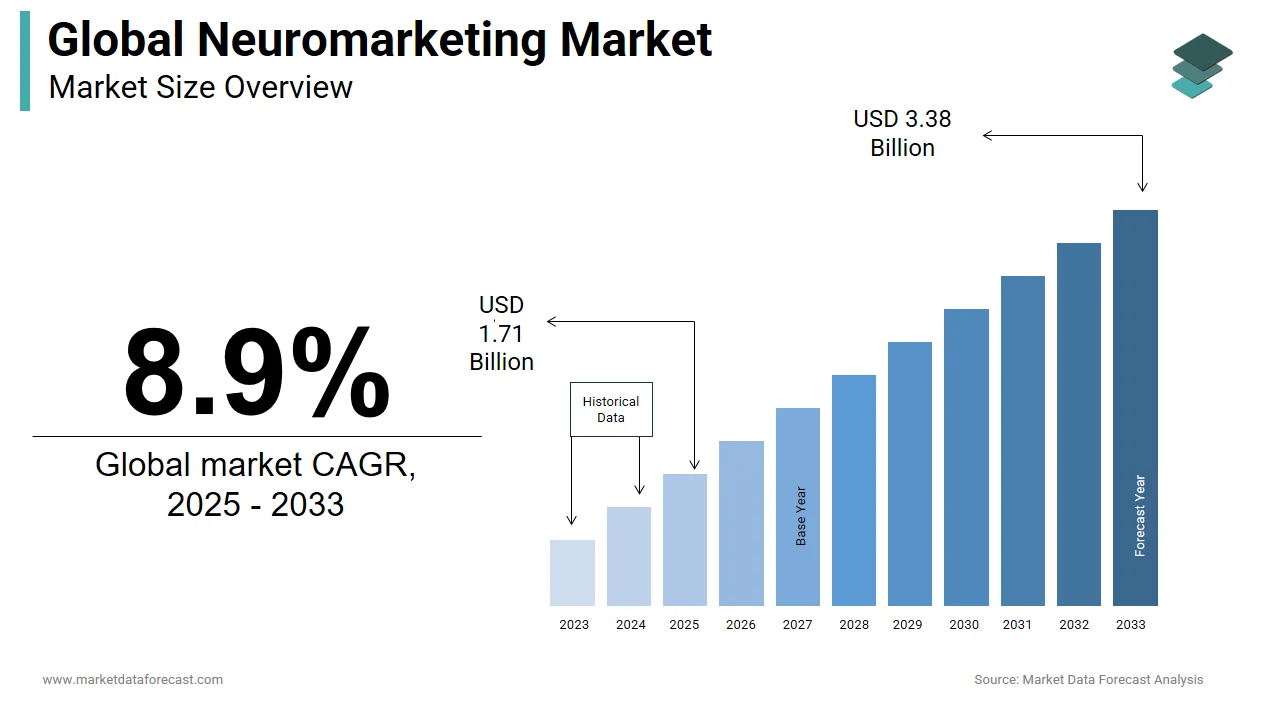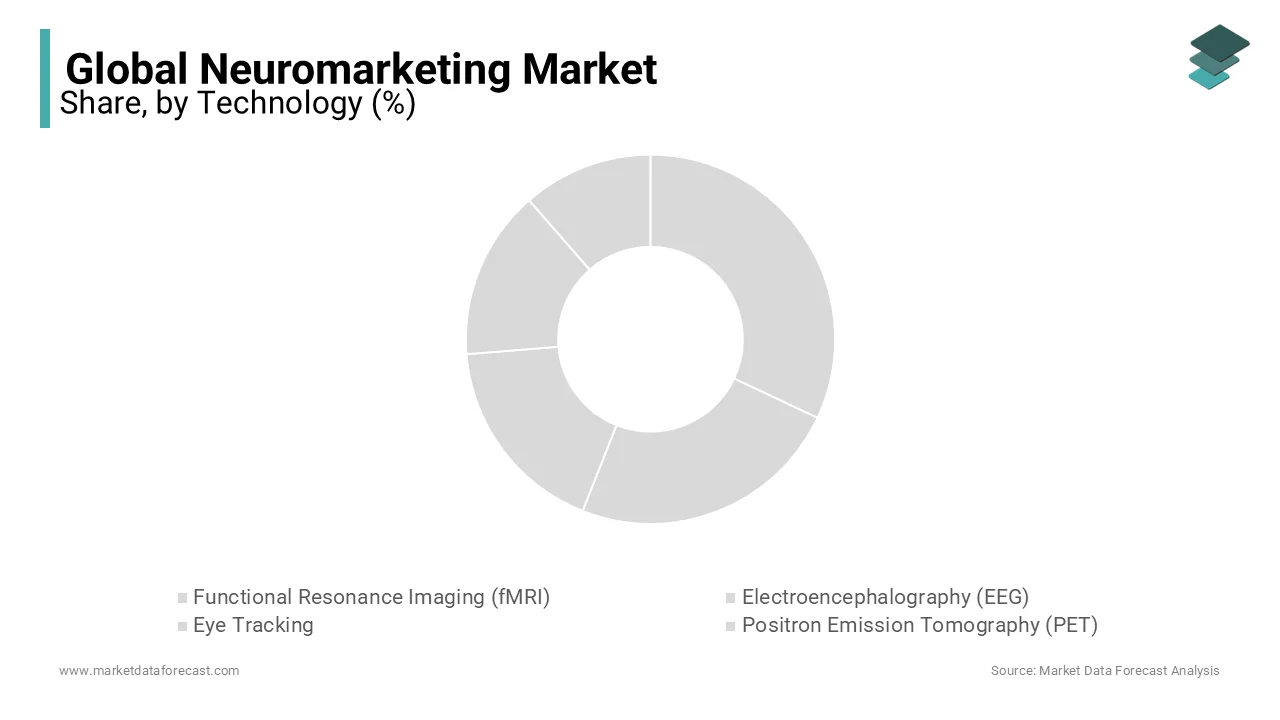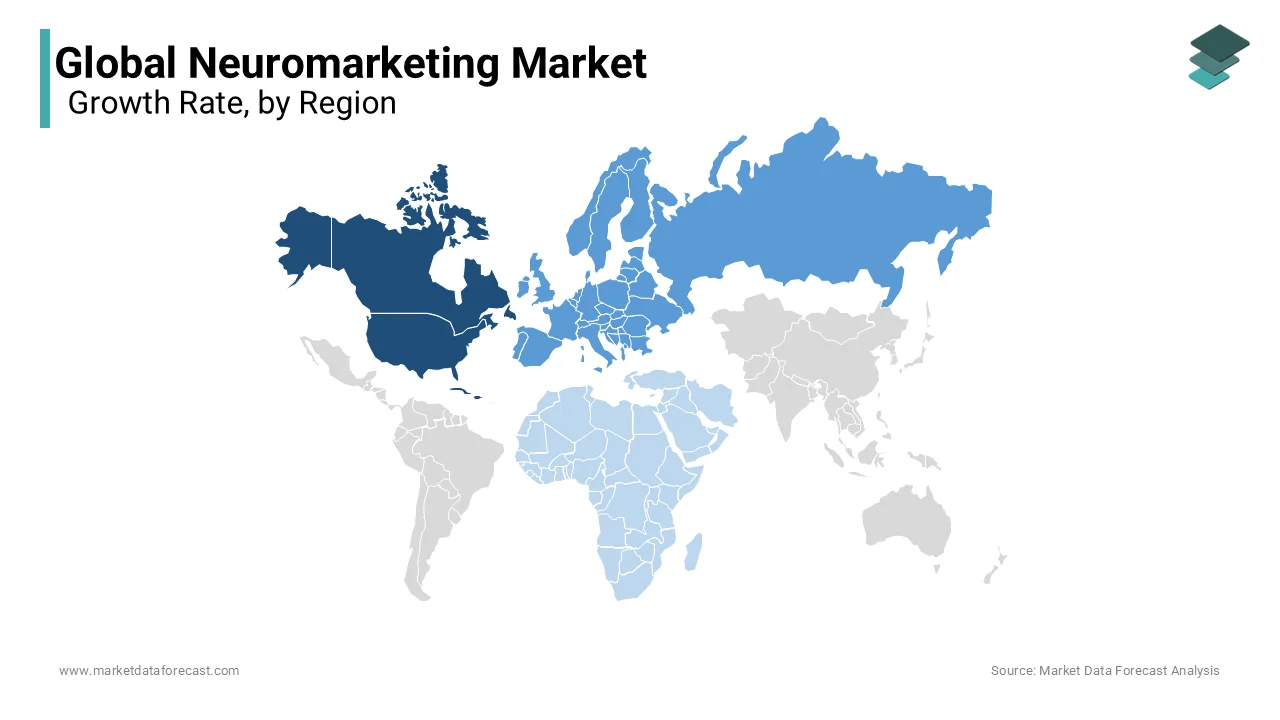Global Neuromarketing Market Size, Share, Trends, & Growth Forecast Report – Segmented by Technology (Functional Resonance Imaging (fMRI), Electroencephalography (EEG), Eye Tracking, Positron Emission Tomography (PET), And Magneto Encephalography (MEG)), End-User (Retail, Healthcare, Food & Beverage, and Consumer Electronics), Solutions (Customer Experience, People Engagement, and Merchandise Development), & Region - Industry Forecast From 2024 to 2032
Global Neuromarketing Market Size (2024 to 2032)
The global neuromarketing market was valued at USD 1.44 billion in 2023. The global market is expected to reach USD 1.57 billion in 2024 and USD 3.11 billion by 2032, growing at a CAGR of 8.9% during the forecast period.

Neuromarketing is the marketing field that uses medical technologies similar to functional magnetic resonance Imaging (fMRI) to review the brain’s responses to marketing stimuli. It is a proper study of the brain's responses to advertising and branding and the adjustment of these messages based on feedback to elicit even better responses. Researchers use different types of technologies to live specific brain activity in response to advertising messages. With this information, companies get to understand the consumers' decision-making skills as well as the driving force toward their persona.
Current Scenario of the Global Neuromarketing Market
Presently, the neuromarketing market is rapidly growing with the integration of advanced technologies. The industry players focus on gauging emotional reactions, looking into viewers' minds, and predicting engagement with their advertising and shows. Moreover, the growing awareness about the probable benefits offered by these techniques is further driving the rapid adoption of varied neuromarketing solutions. Major companies, like PepsiCo, Unilever, eBay, and The Coca-Cola Company, have implemented neuromarketing research techniques to conduct marketing research, run focus groups, and style marketing campaigns. Recently, in June 2024, The World’s Ranking of Companies Behind Most Effective Marketing Initiatives in 2023 was published, according to which FMCG or CPG and fast food and beverage players grabbed the highest spots, with 3 in the top 5 brands being QSRs.
MARKET DRIVERS
The neuromarketing market is driven by developments in neuroscientific technologies and techniques like electroencephalography (EEG), functional magnetic resonance imaging (fMRI), and eye-tracking record consumers' physiological and neurological reactions for factual information about customer responses.
The market growth is also fuelled by the application of behavioural economics to enhance consumer experience. This has greatly boosted the demand for a deeper understanding of customer behavior, preferences, and gaze more often.
Extensive application of digital marketing, social media, and other online services or offerings is another major factor propelling the market. This is because of the capability to individualize experiences and marketing communication based on personal choices and neuroscientific insights.
Increased investment in research and the use of neuroscience for marketing purposes is influencing the demand for neuromarketing among different industries. As per a study, Spain dominated the ranking of publications by countries and has become the most productive with 48 per cent of neuromarketing publications. It is followed by the United States and China.
Additionally, the progressive adoption of techniques such as facial recognition, biometrics, eye-tracking and implicit association tests. Companies are these to boost sales by measuring physiological responses like conductance of the skin and heart rate.
MARKET RESTRAINTS
Ethical and manipulation concerns, high costs, and scalability are the main factors hindering neuromarketing market growth. Government agencies and people have seriously regarded it as a legitimate concern. Like, recently, it was observed same problems arose in methods which track behaviour with little or no personal permission. This intervention by governments and breach of personal space is impeding the growth rate as companies use in-personal interviews which are required to adhere to strict standards, for instance, EU's GDPR regulations and the Declaration of Helsinki. Also, ethical guidelines by institutions like NMSBA and ESOMAR are there to improve clinical research.
MARKET OPPORTUNITIES
The growing tendency to incorporate AI into the neuromarketing field via Brain-Computer Interface (BCI) technology provides a potential and fundamental shift in understanding consumer behavior. This is expected to significantly expand the neuromarketing market. Moreover, there are immense opportunities for digital engagement with the combination of neuralink and neuromarketing. The development of neuralink, which is brain chip technology by Elon Musk, has completely transformed this industry. This will substantially augment the market growth rate by straightaway accessing customers’ neural reactions instead of relying on outside surveys and observations.
MARKET CHALLENGES
The growing covert persuasion to manipulate consumer behavior is increasing concerns regarding customer autonomy and the alteration of people’s decision-making capabilities. This is a key challenge, which is decreasing the expansion rate of the neuromarketing market. Further, the utilization of neuromarketing techniques for unethical or harmful objectives, like marketing products that are injurious to well-being is also a problem. For example, alcohol and tobacco. Hence, this has become a pressing concern for the industry players.
REPORT COVERAGE
|
REPORT METRIC |
DETAILS |
|
Market Size Available |
2023 to 2032 |
|
Base Year |
2023 |
|
Forecast Period |
2024 to 2032 |
|
CAGR |
8.9% |
|
Segments Covered |
By Technology, Solution, End User, and Region |
|
Various Analyses Covered |
Global, Regional & Country Level Analysis, Segment-Level Analysis, DROC, PESTLE Analysis, Porter’s Five Forces Analysis, Competitive Landscape, Analyst Overview on Investment Opportunities |
|
Regions Covered |
North America, Europe, APAC, Latin America, Middle East & Africa |
|
Market Leaders Profiled |
CSS/Data Intelligence (U.S.), The Neilsen Company LLC, (U.S.), Nviso (Switzerland), Olson Zaltman Associates (U.S.), Sensomotoric Instruments GMBH (Germany), Behavior and Brain Lab (Italy), Merchant Mechanics (U.S.), Neural Sense (South Africa), Neurospire Inc. (U.S.), Sr Labs (Italy), Synetiq Ltd, Cadwell Industries Inc. (U.S.), SR Research (Canada), and Compumedics Limited (Australia) and Others. |
SEGMENTAL ANALYSIS
Global Neuromarketing Market Analysis By Technology

The Electroencephalography (EEG) segment holds the maximum share of the neuromarketing market. It is the most prevalent technique used by the industry players. This is the only method for measuring brain activity at the cognitive processing speed. Moreover, the market growth of the segment is due to the growing frequency of neurological disorders, increasing demand for non-invasive diagnostic techniques, and technological developments in EEG. Besides this, the surging older population and growing awareness about the significance of early diagnosis of neurological situations are believed to contribute to the segment’s market size. Additionally, the EEG devices sector witnesses a high standard of innovation, with players continuously developing products that improve efficiency and safety.
Functional Resonance Imaging (fMRI) is the second biggest segment under this category and is anticipated to grow notably in the coming years. This market growth is because of its capability to present comprehensive images of brain activity. This enables an enhanced cognizance of customer responses and marketing reactions.
Global Neuromarketing Market Analysis By End User
The retail segment accounted for the largest share of the neuromarketing market and is estimated to achieve a higher CAGR throughout the forecast period. The heightening demand for neuro-analytics in retail companies has led to the application of neuromarketing technologies. Key consumer brands like PepsiCo, eBay, The Weather Channel, Daimler, Frito-Lay, Campbell's, Gerber, and others have applied this research method to understand consumer behaviour, conduct industry research, and improve their business strategies. These technologies give valuable insights into consumer preferences, assisting players in making data-driven decisions and consolidating their position in the industry.
The consumer electronics segment is also expected to grow rapidly owing to persistent technological advancements and growing middle-class consumer spending in emerging countries.
Global Neuromarketing Market Analysis By Solution
The consumer experience is the dominant segment of the neuromarketing market. This can be linked to the increased focus on improving service quality and overall shopping experience to retain existing and attract new customers. The market companies are progressively using various techniques to gain insight into how the consumer’s brain processes data to make decisions and preferences. They are also tracking emotions which are a deciding element while reaching the purchase decisions. Additionally, the industry is also expanding due to the growing collaboration between companies and technology providers. This includes technologies like facial recognition and eye-tracking.
REGIONAL ANALYSIS

North America is the biggest neuromarketing industry and accounts for the maximum market share. In the coming years, the United States will continue to lead the regional market and will play an extremely crucial role in technological advancements and trends in the neuromarketing market. In addition, the progressive development and adoption of modern technology and the prominence of big companies in the continent are expected to provide pathbreaking prospects for the market. Moreover, the use of colour psychology in branding by the market players is also fuelling the demand for neuromarketing. Cola-Cola and McDonald's are examples.
Europe is the leader in neuromarketing publications and is rapidly driving forward. This can be attributed to the presence of productive institutions in this research. The Complutense Madrid University in Spain leads the ranking with 21 papers followed by Roma la Sapienza University in Italy. Also, Spanish researchers emphasize advertising, especially online advertisements, promotions, and TV Commercials, coupled with the use of image and sound effects on consumer behaviour. The articles published by Spanish research establishments employ eye tracking, galvanic skin reaction, electroencephalography (EEG), and functional magnetic resonance imaging (fMRI) technology. Other prominent countries in this industry are Germany, the UK, Lithuania, the Netherlands, Denmark and France.
Asia Pacific neuromarketing market is the fastest growing industry. The regional market is propelled by China which is the third most productive country worldwide in publishing neuromarketing with 24 per cent of all Scopus. Consumer association and branding strategy in connection to TV commercials, tourism and colour alliance are the most-researched topics in Chinese institutions. Apart from this, according to industry experts, the total customer spending is expected to rise by 2.5 folds and is a consumption-driven economy. Neuroscience has an expanding role in India. Thus, it becomes highly important to correctly judge consumer behaviour and preferences to advance in the Country’s market.
Latin America is predicted to register considerable growth for the neuromarketing market. The key players in the region are Forebrain (Brazil), MindMetriks (Argentina and Brazil), and Neurons Inc. Brazil. Moreover, the area emphasises consumer-oriented strategies and the rising adoption of advanced technologies for neuromarketing purposes. The market is expected to witness significant change with the creation of new rights for the human brain also known as Neurorights. This happened due to the landmark ruling by the Chilean Supreme Court to protect the brain from machine mining and exploitation. And, the trend is quickly spreading across the region from Brazil to Mexico to Uruguay.
The Middle East and Africa is a smaller industry for the neuromarketing market and is led by the United Arab Emirates (UAE). The market in the country’s retail sector is the front-runner in using these techniques. Further, the region is also experiencing the application of facial coding and eye-tracking technologies. Additionally, the automotive industry in the MEA region is a key end-user of neuromarketing.
KEY MARKET PARTICIPANTS IN THE GLOBAL NEUROMARKETING MARKET
The major companies operating in the global neuromarketing market include CSS/Data Intelligence (U.S.), The Neilsen Company LLC (U.S.), Nviso (Switzerland), Olson Zaltman Associates (U.S.), Sensomotoric Instruments GMBH (Germany), Behavior and Brain Lab (Italy), Merchant Mechanics (U.S.), Neural Sense (South Africa), Neurospire Inc. (U.S.), Sr Labs (Italy), Synetiq Ltd, Cadwell Industries Inc. (U.S.), SR Research (Canada), and Compumedics Limited (Australia), and others.
RECENT HAPPENINGS IN THE GLOBAL NEUROMARKETING MARKET
- In June 2024, Zeto, a medical device company, received approval from the FDA for its EEG brain monitoring system.
- In September 2023, Affectiva Press released the introduction of an innovative attention metric in its cloud-based Emotion AI products. This metric shows a considerable jump in the management of viewer attention for entertainment companies, brands, advertisers, and their market researchers. It is also strengthened by the advanced automotive safety-grade eye-tracking technology by Smart Eye.
DETAILED SEGMENTATION OF THE GLOBAL NEUROMARKETING MARKET INCLUDED IN THIS REPORT
This research report on the global neuromarketing market has been segmented and sub-segmented based on the technology, solution, end-user, and region.
By Technology
-
Functional Resonance Imaging (fMRI)
-
Electroencephalography (EEG)
-
Eye Tracking
-
Positron Emission Tomography (PET)
-
Magneto Encephalography (MEG)
By End User
-
Retail
-
Healthcare
-
Food & Beverage
-
Consumer Electronics
By Solution
-
Customer Experience
-
People Engagement
-
Merchandise Development
By Region
-
North America
-
The United States
-
Canada
-
Rest of North America
-
-
Europe
-
The United Kingdom
-
Spain
-
Germany
-
Italy
-
France
-
Rest of Europe
-
-
The Asia Pacific
-
India
-
Japan
-
China
-
Australia
-
Singapore
-
Malaysia
-
South Korea
-
New Zealand
-
Southeast Asia
-
-
Latin America
-
Brazil
-
Argentina
-
Mexico
-
Rest of LATAM
-
-
The Middle East and Africa
-
Saudi Arabia
-
UAE
-
Lebanon
-
Jordan
-
Cyprus
-
Frequently Asked Questions
Which industries are leveraging neuromarketing techniques effectively?
Various industries, including retail, advertising, entertainment, and healthcare, have embraced neuromarketing to enhance marketing strategies, product development, and customer engagement. Companies in these sectors utilize neuromarketing insights to gain a competitive edge and better resonate with their target audiences.
Can neuromarketing predict consumer behavior accurately?
Neuromarketing can provide valuable insights into consumer behavior by accessing subconscious responses that may not be captured through traditional methods. While it can enhance predictive capabilities, it is not without limitations, and factors such as individual differences and contextual influences still play significant roles in consumer decision-making.
How does cultural diversity impact the effectiveness of neuromarketing strategies?
Cultural differences can influence consumer perceptions, preferences, and responses to marketing stimuli. Therefore, neuromarketing strategies must consider cultural nuances to ensure effectiveness across diverse markets. Tailoring approaches to specific cultural contexts enhances resonance and avoids misinterpretation.
What are the future prospects for the global neuromarketing market?
The future of the global neuromarketing market looks promising, driven by ongoing technological advancements, increasing demand for consumer insights, and a growing recognition of the importance of subconscious influences on decision-making. As businesses continue to prioritize understanding their customers, neuromarketing will likely play an increasingly integral role in shaping marketing strategies worldwide.
Related Reports
Access the study in MULTIPLE FORMATS
Purchase options starting from $ 2500
Didn’t find what you’re looking for?
TALK TO OUR ANALYST TEAM
Need something within your budget?
NO WORRIES! WE GOT YOU COVERED!
Call us on: +1 888 702 9696 (U.S Toll Free)
Write to us: [email protected]